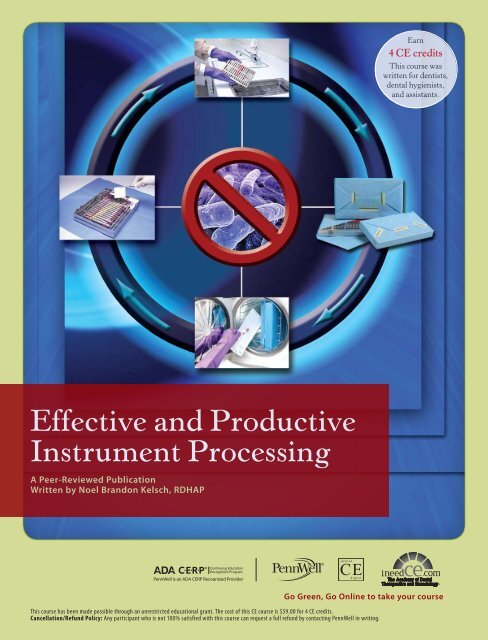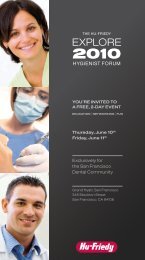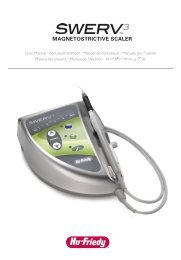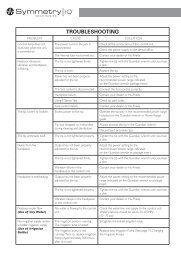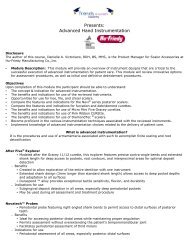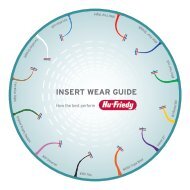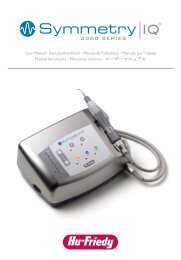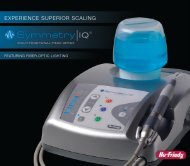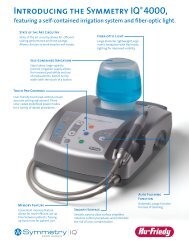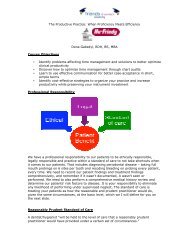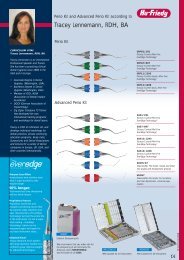Effective and Productive Instrument Processing - Friends of Hu-Friedy
Effective and Productive Instrument Processing - Friends of Hu-Friedy
Effective and Productive Instrument Processing - Friends of Hu-Friedy
Create successful ePaper yourself
Turn your PDF publications into a flip-book with our unique Google optimized e-Paper software.
<strong>Effective</strong> <strong>and</strong> <strong>Productive</strong><br />
<strong>Instrument</strong> <strong>Processing</strong><br />
A Peer-Reviewed Publication<br />
Written by Noel Br<strong>and</strong>on Kelsch, RDHAP<br />
Earn<br />
4 CE credits<br />
This course was<br />
written for dentists,<br />
dental hygienists,<br />
<strong>and</strong> assistants.<br />
Go Green, Go Online to take your course<br />
This course has been made possible through an unrestricted educational grant. The cost <strong>of</strong> this CE course is $59.00 for 4 CE credits.<br />
Cancellation/Refund Policy: Any participant who is not 100% satisfied with this course can request a full refund by contacting PennWell in writing.
Educational Objectives<br />
The overall goal <strong>of</strong> this course is to provide information on infection control<br />
in the dental <strong>of</strong>fice. Upon completion <strong>of</strong> this course, the clinician will<br />
be able to do the following:<br />
1. Describe the chain <strong>of</strong> infection <strong>and</strong> modes <strong>of</strong> transmission <strong>of</strong><br />
microorganisms in the dental <strong>of</strong>fice.<br />
2. Know <strong>and</strong> underst<strong>and</strong> the four basic principles <strong>and</strong> goals to reduce<br />
microbial transmission.<br />
3. Know which instruments must be sterilized, the methods by which<br />
this can be achieved, <strong>and</strong> the role <strong>and</strong> importance <strong>of</strong> external <strong>and</strong><br />
internal indicators on packaging.<br />
4. Underst<strong>and</strong> instrument processing steps <strong>and</strong> the use <strong>of</strong> instrument<br />
management systems in this process.<br />
Abstract<br />
In order to meet the challenges <strong>of</strong> safety, time management <strong>and</strong> asepsis,<br />
the dental health care provider must have a plan for infection control,<br />
including the use <strong>and</strong> care <strong>of</strong> dental instruments <strong>and</strong> disposables. Following<br />
the basic CDC guidelines can help to significantly reduce the risk <strong>of</strong><br />
microbial transmission. After the patient is dismissed, the operatory must<br />
be prepared for the next patient, including the treatment <strong>of</strong> surfaces <strong>and</strong><br />
instrument processing. There is a variety <strong>of</strong> methods available to properly<br />
reprocess instruments. Choosing a system that minimizes risk, maximizes<br />
productivity <strong>and</strong> preserves instruments is essential.<br />
Introduction<br />
One <strong>of</strong> the most stressful times in dentistry can be the result <strong>of</strong> a<br />
single missing, damaged or nonsterile instrument. In order to meet<br />
the challenges <strong>of</strong> safety, time management <strong>and</strong> asepsis, the dental<br />
health care provider (DHCP) must have a plan for infection control,<br />
including the use <strong>and</strong> care <strong>of</strong> dental instruments. The plan must<br />
meet the guidelines <strong>of</strong> the Occupational Safety <strong>and</strong> Health Administration<br />
(OSHA) <strong>and</strong> the Centers for Disease Control (CDC).<br />
The chain <strong>of</strong> infection<br />
In order for a disease to occur, a number <strong>of</strong> conditions must exist.<br />
These conditions, called the chain <strong>of</strong> infection, are:<br />
1. An appropriate portal <strong>of</strong> entry for a pathogen into a new host<br />
2. A person who is not immune to the pathogen<br />
3. A pathogen in sufficient numbers to cause infection<br />
4. A place for the pathogen to reside <strong>and</strong> multiply<br />
5. A way for the pathogen to leave its reservoir <strong>and</strong> reach the<br />
new host<br />
All five conditions must be present for disease to occur. 1<br />
Modes <strong>of</strong> transmission<br />
During <strong>and</strong> following dental treatment, diseases can be transmitted<br />
between:<br />
• Patient <strong>and</strong> dental staff • Dental staff <strong>and</strong> patient<br />
• Patient <strong>and</strong> patient • Dental staff <strong>and</strong> dental staff<br />
In general, it is more likely that diseases would be transmitted<br />
from patients to clinicians than vice versa, because clinicians have<br />
frequent contact with patients’ saliva <strong>and</strong> blood during dental<br />
procedures.<br />
Occupational Exposure<br />
Exposure <strong>of</strong> DHCPs <strong>and</strong> patients to pathogenic microorganisms<br />
can result from transmission through:<br />
• Direct contact with blood, oral fluids, or other patient tissues<br />
• Direct contact <strong>of</strong> intact or nonintact skin with blood, oral<br />
fluids or other potentially infectious patient materials<br />
• Contact <strong>of</strong> conjunctival, nasal or oral mucosa with droplets<br />
(spray or spatter) containing microorganisms generated from<br />
an infected person <strong>and</strong> propelled a short distance (e.g., by<br />
coughing, sneezing or talking)<br />
• Inhalation <strong>of</strong> airborne microorganisms that can remain<br />
suspended in the air for long periods 1<br />
• Indirect contact with contaminated objects (e.g., instruments,<br />
equipment or environmental surfaces)<br />
Cross-contamination <strong>and</strong> Cross-infection<br />
During treatment, areas <strong>of</strong> the operatory can become contaminated<br />
with pathogens from blood, saliva <strong>and</strong> other body fluids. For<br />
example, when working with equipment such as ultrasonic scalers<br />
<strong>and</strong> high-speed h<strong>and</strong>pieces, aerosols are created that can l<strong>and</strong> on<br />
environmental surfaces. When the DHCP touches those surfaces,<br />
the microorganisms can be transferred to his or her h<strong>and</strong>s. If the<br />
DHCP does not wash his or her h<strong>and</strong>s <strong>and</strong> then touches his or her<br />
eyes, mouth or nose, the microorganisms can enter the provider as<br />
a host. If the DHCP greets a patient <strong>and</strong> shakes his or her h<strong>and</strong>,<br />
transfer <strong>of</strong> the bacteria or virus to the patient can also occur. This<br />
process, called cross-contamination or cross-infection, can place<br />
the DHCP <strong>and</strong> patients at risk. 2,3<br />
Limiting Exposure through Infection Control<br />
Although a DHCP’s work may increase the risk <strong>of</strong> infection, a<br />
number <strong>of</strong> procedures used routinely in dental settings help keep<br />
that risk to a minimum.<br />
Table 1. The Four Basic Principles<br />
Keep yourself healthy. This has a major impact on disease transmission.<br />
It emphasizes the need for dental personnel to be protected<br />
through immunizations, work restrictions <strong>and</strong> regular h<strong>and</strong> hygiene.<br />
Avoid contact with blood <strong>and</strong> body fluids. This focuses on the use <strong>of</strong><br />
st<strong>and</strong>ard precautions, engineering controls <strong>and</strong> work practice controls.<br />
This principle also emphasizes the use <strong>of</strong> personal protection equipment<br />
(PPE) to prevent bloodborne exposure, as well as the management <strong>of</strong><br />
postexposure incidents.<br />
Limit contamination. This involves conducting general housekeeping,<br />
covering <strong>and</strong> disinfecting environmental surfaces, minimizing sprays <strong>and</strong><br />
splashes, properly disposing <strong>of</strong> medical waste, <strong>and</strong> maintaining water<br />
quality in dental unit waterlines. 4<br />
Make objects safe for use. Single-use items <strong>and</strong> thorough cleaning<br />
<strong>and</strong> sterilization <strong>of</strong> patient care items help in this area. Using instrument<br />
management systems can help minimize h<strong>and</strong>ling, sharps injuries <strong>and</strong><br />
exposure. Simply placing an instrument setup into a cassette limits DHCP<br />
exposure to sharps <strong>and</strong> contaminated instruments <strong>and</strong> allows for a more<br />
automated cleaning process.<br />
Infection control refers to the basic principles <strong>and</strong> series <strong>of</strong> steps<br />
that help prevent disease transmission. Following the basic<br />
guidelines that the CDC has provided can help to significantly<br />
2 www.ineedce.com
educe the risk <strong>of</strong> microbial transmission in the dental setting.<br />
The goal <strong>of</strong> each <strong>of</strong> the four basic principles is to break one or<br />
more links in the chain <strong>of</strong> infection. 5<br />
St<strong>and</strong>ard precautions<br />
Universal precautions were created in the 1980s to help protect<br />
against bloodborne disease transmission. In dentistry, these include<br />
h<strong>and</strong> washing; use <strong>of</strong> PPE such as gloves, eyewear <strong>and</strong> face<br />
protection; <strong>and</strong> recommendations for proper h<strong>and</strong>ling <strong>of</strong> patient<br />
care items <strong>and</strong> contaminated surfaces. As the word “universal”<br />
suggests, the precautions are applied when treating all patients, regardless<br />
<strong>of</strong> health history or presumed risk <strong>of</strong> bloodborne disease.<br />
In the mid-1990s, the term “st<strong>and</strong>ard precautions” was introduced.<br />
While universal precautions focus mainly on preventing<br />
exposure to blood, st<strong>and</strong>ard precautions guard against exposure to<br />
all body fluids (except sweat, which is not considered infectious). 6<br />
In the dental setting, there is little practical difference between<br />
universal <strong>and</strong> st<strong>and</strong>ard precautions. All <strong>of</strong> the precautions traditionally<br />
used to protect against blood <strong>and</strong> blood-contaminated<br />
saliva also protect against exposure to any other fluids that would<br />
typically be encountered in the dental setting. The DHCP should<br />
treat every patient as if he or she could be a source <strong>of</strong> infection.<br />
Using st<strong>and</strong>ard precautions limits cross-contamination <strong>and</strong><br />
cross-infection. 7,8 Single-use surface barriers such as plastic wrap or<br />
sheaths prevent contamination <strong>of</strong> surfaces. 9 These barriers should<br />
be used on as many surfaces as possible, <strong>and</strong> especially on surfaces<br />
that are difficult to access or disinfect (such as X-ray tubes). The<br />
use <strong>of</strong> barriers is reliable, saves time <strong>and</strong> reduces exposure to<br />
chemicals. 10 Clinical contact surfaces that do not have barrier covers<br />
or become contaminated during removal <strong>of</strong> the barrier require<br />
surface disinfection. Disinfection should be carried out using an<br />
EPA-registered disinfectant with tuberculocidal activity (i.e.,<br />
CDC intermediate-level disinfectant) or a low-level disinfectant.<br />
Personnel <strong>and</strong> patients rarely come in contact with housekeeping<br />
surfaces. These require regular cleaning to remove soil <strong>and</strong> dust.<br />
These areas include floors, walls <strong>and</strong> some countertops. Cleaning<br />
should include use <strong>of</strong> an EPA-registered hospital disinfectant with<br />
no tuberculocidal activity (i.e., CDC low-level disinfectant) or an<br />
intermediate-level disinfectant if blood is visible.<br />
Figure 1. Disinfection <strong>of</strong> Surfaces<br />
Surface<br />
Type<br />
Clinical contact<br />
surfaces<br />
Housekeeping<br />
surfaces<br />
Single-use<br />
barrier covers<br />
CDC intermediate-level<br />
or low-level disinfectant<br />
No blood present<br />
Blood present<br />
+ disinfectant if surface<br />
contaminated<br />
CDC low-level<br />
disinfectant<br />
CDC intermediate-level<br />
disinfectant<br />
In summary, with vaccination; appropriate h<strong>and</strong> hygiene; careful<br />
h<strong>and</strong>ling <strong>of</strong> sharp items; use <strong>of</strong> barrier techniques; <strong>and</strong> proper<br />
cleaning, disinfection <strong>and</strong> sterilization procedures, you can meet<br />
many requirements for a safe workplace. <strong>Instrument</strong> processing<br />
is a key component <strong>and</strong>, when performed appropriately, breaks<br />
the chain <strong>of</strong> infection, reduces DHCP stress, improves productivity<br />
<strong>and</strong> staff safety, <strong>and</strong> results in cost savings.<br />
<strong>Instrument</strong> <strong>Processing</strong> <strong>and</strong> Infection Control<br />
After the patient is dismissed, the operatory must be prepared<br />
for the next patient, including the treatment <strong>of</strong> surfaces <strong>and</strong><br />
instrument processing. This process must be performed correctly<br />
every time to ensure items are properly processed. Having<br />
working, organized, sharp, debris-free <strong>and</strong> sterile (or disposable)<br />
instruments aids in the <strong>of</strong>fice’s production, the quality <strong>of</strong><br />
dentistry, <strong>and</strong> the safety <strong>of</strong> patients <strong>and</strong> staff. Quality sterile<br />
dental instruments are key to the practice <strong>of</strong> dentistry. Choosing<br />
a system that minimizes risk, maximizes productivity <strong>and</strong> saves<br />
money is important. In addition, while some instruments must<br />
be disposable, limiting the disposal <strong>of</strong> reusable devices helps<br />
keep the world greener. Using instrument cassettes minimizes<br />
DHCP contact with contaminated instruments, organizes the<br />
instruments for safe <strong>and</strong> efficient processing, keeps the instruments<br />
free from debris, protects instruments from damage <strong>and</strong><br />
helps instruments remain sterile after processing. Sterilization<br />
cassettes also st<strong>and</strong>ardize procedural setups by organizing the<br />
instruments by procedure or type <strong>of</strong> user. This st<strong>and</strong>ardization<br />
enables any staff member to quickly identify the proper cassette<br />
for every procedure. Cassettes help eliminate lost instruments<br />
during instrument processing or transportation to <strong>and</strong> from the<br />
operatory. Dr. Lou Graham found that by creating st<strong>and</strong>ardized<br />
setups <strong>and</strong> using the cassette system in his <strong>of</strong>fice, his staff saved<br />
an average <strong>of</strong> five minutes per procedure, which allowed the staff<br />
to spend more time with patients <strong>and</strong> contributed to productivity<br />
<strong>and</strong> therefore revenue generation. 11 <strong>Instrument</strong> processing<br />
requires consideration <strong>of</strong> the necessary equipment, workflow <strong>and</strong><br />
stages involved. In general, the processing can be divided into a<br />
chairside component <strong>and</strong> a processing area component.<br />
Having organized, sharp, <strong>and</strong> sterile (or disposable) instruments<br />
aids in production, the quality <strong>of</strong> dentistry, <strong>and</strong> safety.<br />
Chairside Procedure<br />
Single-use disposable instruments<br />
These are designed to be used only once - for one patient <strong>and</strong><br />
discarded appropriately. They cannot be cleaned, disinfected<br />
or sterilized. These include blades, needles, prophylaxis angles,<br />
carpules, cups <strong>and</strong> brushes, evacuator tips, saliva ejectors, <strong>and</strong><br />
air/water syringe tips. 3 These items are becoming more <strong>and</strong><br />
more available <strong>and</strong> economical. They eliminate the chance <strong>of</strong><br />
cross-contamination, the need for extensive postoperative h<strong>and</strong>ling<br />
(with a risk <strong>of</strong> sharps injuries) <strong>and</strong> exposure to sterilization<br />
chemicals. Disposing <strong>of</strong> all single-use items immediately after<br />
treatment limits the risk <strong>of</strong> sharps injuries.<br />
The CDC recommends that there be a sharps container in every<br />
room in which treatment is delivered. Placing sharps in the<br />
container as soon as possible eliminates the hazard quickly.<br />
www.ineedce.com 3
Disposal <strong>of</strong> sharps <strong>and</strong> prevention <strong>of</strong> sharps injuries<br />
Disposing <strong>of</strong> sharps is one <strong>of</strong> the riskiest tasks in dentistry. 9,12,13 All<br />
operatories that include use <strong>of</strong> disposable sharps (needles, blades,<br />
wires, etc.) should have a sharps container in the room. 5 All sharps<br />
should be removed from the tray <strong>and</strong> disposed <strong>of</strong> as soon as treatment<br />
is completed to decrease the risk <strong>of</strong> a sharps injury.<br />
Figure 2. Sharps Container<br />
One available device melts down <strong>and</strong> compresses used needles,<br />
needle sheaths <strong>and</strong> red bag waste into a disposable block (Demolizer<br />
II, BMTS). It is approved in most states <strong>and</strong> meets EPA <strong>and</strong><br />
OSHA requirements. While not reducing the risk <strong>of</strong> sharps injuries<br />
during the removal <strong>of</strong> sharps, it <strong>of</strong>fers a disposal alternative.<br />
Figure 3. Demolizer<br />
Disposal <strong>of</strong> non-sharps patient care items<br />
It is important to contact your area waste management system<br />
to see if they allow empty carpules to go out with the general<br />
trash. Regulations vary by state for the disposal <strong>of</strong> intact, broken,<br />
blood-filled <strong>and</strong> empty carpules. Most disposable items can go<br />
out with the general trash. The exception is cotton materials that<br />
are soaked with blood to the point that blood can be wrung out<br />
<strong>of</strong> them. Clearing the tray <strong>of</strong> all non-sharp disposables early on<br />
will give the DHCP a clear view <strong>of</strong> sharps <strong>and</strong> instruments <strong>and</strong><br />
decrease the likelihood <strong>of</strong> injury. 6<br />
The <strong>Instrument</strong> <strong>Processing</strong> Area<br />
The flow, layout <strong>and</strong> appropriate use <strong>of</strong> the instrument processing<br />
area are determining factors in successful sterilization. Office<br />
policy should include the use <strong>of</strong> puncture- <strong>and</strong> chemical-resistant<br />
utility gloves by DHCPs when cleaning dental instruments <strong>and</strong><br />
working with chemicals. Latex gloves are not puncture-resistant<br />
<strong>and</strong> can break down in the presence <strong>of</strong> chemicals. OSHA guidelines<br />
specifically state, “The person h<strong>and</strong>ling the instruments<br />
through removal, cleaning, packaging <strong>and</strong> sterilization needs to<br />
use heavy-duty gloves to help prevent injury with sharp contaminated<br />
instruments.” Many DHCPs complain that heavy-duty<br />
gloves do not have the same tactile sensitivity as examination<br />
gloves. However, the fine tactile sensitivity that is needed during<br />
dental procedures is not necessary during instrument cleaning<br />
<strong>and</strong> sterilization. Additionally, some utility gloves come sized to<br />
meet your individual needs.<br />
Figure 4. Use <strong>of</strong> Utility Gloves<br />
The DHCP must wear proper protective equipment, including<br />
utility gloves, mask, glasses, <strong>and</strong> clinic gown or jacket, during<br />
instrument processing. Properly fitting masks, protective eye wear<br />
<strong>and</strong> a full gown must also be utilized to avoid contact with splashes,<br />
sprays <strong>and</strong> aerosols that are present in the sterilization area. The<br />
instrument processing area should be separated into four specific<br />
areas as far apart as possible <strong>and</strong> with clearly defined “clean” <strong>and</strong><br />
“dirty” areas. The separate areas involved in instrument processing<br />
are as follows:<br />
Receiving, Cleaning <strong>and</strong> Decontamination<br />
Cassettes <strong>and</strong> instruments are placed here for removal <strong>of</strong> debris<br />
before processing. This area should be clearly defined to prevent<br />
cross-contamination. It is recommended that instrument h<strong>and</strong>ling<br />
be minimized, as this is where a high percentage <strong>of</strong> sharps<br />
injuries occur. Specific containers are also available for syringes,<br />
burs <strong>and</strong> other instruments. H<strong>and</strong>pieces must be heat-sterilized<br />
(autoclaved) after single patient use, <strong>and</strong> it is important to follow<br />
the manufacturer’s instructions on cleaning, lubrication <strong>and</strong><br />
sterilizing h<strong>and</strong>pieces to ensure proper sterilization <strong>and</strong> to avoid<br />
h<strong>and</strong>piece damage.<br />
Preparation <strong>and</strong> Packaging<br />
This area must have enough space for safe packaging <strong>and</strong> preparation.<br />
Supplies should be readily available to eliminate the chance<br />
<strong>of</strong> contaminating drawer h<strong>and</strong>les <strong>and</strong> cupboards. Before preparing<br />
<strong>and</strong> packaging, all instruments <strong>and</strong> other patient care items should<br />
be inspected for cleanliness <strong>and</strong> completely dried.<br />
4 www.ineedce.com
Sterilization<br />
This is the most important area in the process. Contaminated<br />
items go into the sterilizer. If the sterilizer is working properly<br />
<strong>and</strong> the appropriate process is followed, instruments <strong>and</strong> other<br />
patient care items will be sterile. To prevent contamination <strong>of</strong><br />
the front <strong>and</strong> h<strong>and</strong>les <strong>of</strong> the sterilizer during the loading process,<br />
simply open the sterilizer door with a paper towel.<br />
Tips for <strong>Instrument</strong> <strong>Processing</strong> Areas<br />
• Every DHCP should have a personal set <strong>of</strong> heavy-duty utility gloves,<br />
disinfected <strong>and</strong> evaluated for cracks <strong>and</strong> integrity daily. This will help<br />
with compliance <strong>and</strong> guard against sharps injuries.<br />
• To prevent having to change gloves, keep a spare set <strong>of</strong> clean cotton<br />
forceps or a set <strong>of</strong> tongs to open <strong>and</strong> take things out <strong>of</strong> drawers <strong>and</strong><br />
cupboards.<br />
• Keep sterilization pouches in an open, easy-to-access location to<br />
eliminate the risk <strong>of</strong> cross-contamination from opening drawers <strong>and</strong><br />
cupboards.<br />
• Having the sterilizer divide the room between clean <strong>and</strong> dirty (one<br />
side is the dirty side, one side is the clean side) is a simple way to help<br />
everyone underst<strong>and</strong> the concept.<br />
• An instrument management system that includes procedure tubs <strong>and</strong><br />
cassettes is the most efficient <strong>and</strong> organized way to manage instruments<br />
<strong>and</strong> consumable products, <strong>and</strong> saves time.<br />
• Procedure tubs <strong>and</strong> cassettes limit exposure to pathogens <strong>and</strong> sharps<br />
injuries.<br />
Storage<br />
The storage <strong>of</strong> instruments <strong>and</strong> cassettes following sterilization<br />
should preserve the integrity <strong>of</strong> the packaging material. Sterilized<br />
items should be stored in a clean, dry environment away from<br />
areas where contaminated instruments are present. Do not store<br />
instruments or supplies under sinks, over sterilization devices,<br />
or in areas where moisture or environmental factors could contaminate<br />
the packaging. To optimize organization <strong>of</strong> supplies,<br />
keeping tubs for supplies in a central location is ideal. Having<br />
a separate tub for different procedures saves time searching for<br />
<strong>and</strong> gathering supplies <strong>and</strong> maximizes use <strong>of</strong> materials. A simple<br />
inventory list accompanying each tub will help all staff maintain<br />
the system easily. These tubs can act as portable operatory drawers<br />
for storing, organizing <strong>and</strong> transporting consumable materials<br />
to <strong>and</strong> from storage, the sterilization area <strong>and</strong> the operatory.<br />
Figure 5. Organization <strong>of</strong> Consumable Materials in Tubs<br />
<strong>Instrument</strong> <strong>Processing</strong> <strong>of</strong> Non-disposable Items<br />
<strong>Hu</strong>man error is the most common reason for failure. The instrument<br />
management process must be followed appropriately<br />
every time.<br />
Divide <strong>and</strong> conquer<br />
Before processing instruments, it is important to divide them into<br />
categories <strong>of</strong> use. Critical instruments are surgical <strong>and</strong> other instruments<br />
used to penetrate the mucosa <strong>and</strong> bone. This category includes<br />
bone chisels, scalers <strong>and</strong> burs. Critical instruments require<br />
heat sterilization or must be single-use disposable. Sterilization is<br />
achieved by steam under pressure (autoclaving), dry heat or heat/<br />
chemical sterilization. Semi-critical instruments are surgical <strong>and</strong><br />
other instruments that are not used to penetrate s<strong>of</strong>t tissue or bone,<br />
but come in contact with the oral tissue. These require heat sterilization<br />
or, if an item is heat sensitive, immersion in a high-level<br />
disinfectant/sterilant. A high-level disinfectant registered with<br />
the EPA as a sterilant/disinfectant must be clearly labeled as such.<br />
Noncritical instruments are instruments that only come in contact<br />
with intact skin. They do not come in contact with mucosa. These<br />
can be sterilized by immersing them in a high-level disinfectant<br />
or can be processed with an intermediate-level disinfectant. Such<br />
devices have a relatively low risk <strong>of</strong> transmitting infection. An<br />
intermediate-level disinfectant will be labeled as a hospital disinfectant<br />
<strong>and</strong> also for tuberculocidal activity (exemplified by phenolics,<br />
iodophors <strong>and</strong> chlorine-based compounds). 14<br />
Transporting instruments<br />
Once all disposables <strong>and</strong> sharps are removed from the counter or<br />
chair tray <strong>and</strong> placed in the proper receptacles, all instruments<br />
should be kept in cassettes to limit h<strong>and</strong>ling <strong>and</strong> decrease the risk<br />
<strong>of</strong> sharps injury. Using instrument cassettes <strong>and</strong> sorting devices<br />
can make all the difference in the preparation <strong>and</strong> packaging area.<br />
Cassettes not only hold the instruments securely during cleaning<br />
<strong>and</strong> sterilization, but they also limit dulling, instrument loss,<br />
sharps injuries, warping <strong>of</strong> instruments <strong>and</strong> the frustration <strong>of</strong><br />
trying to find missing instruments. 15 Using cassettes also helps<br />
avoid overloading the sterilizers with contaminated instruments,<br />
which can affect sterilization efficacy. Cassettes can be used for all<br />
instruments associated with specific procedures. A wide variety <strong>of</strong><br />
cassettes is available to meet all instrument needs. Cassette accessories<br />
are available <strong>and</strong> sized for specific items such as burs.<br />
The CDC guidelines state that “contaminated instruments<br />
should be h<strong>and</strong>led very carefully to prevent exposure to sharps<br />
instruments that can cause percutaneous injury. <strong>Instrument</strong>s<br />
should be placed in an appropriate container at the point <strong>of</strong> use<br />
to prevent percutaneous injuries during transportation to the<br />
instrument processing area.” Locking, covered tubs developed<br />
for transport <strong>and</strong> storage <strong>of</strong> consumable materials help reduce<br />
exposure to cross-contamination. Using a color-coded system<br />
for cassettes <strong>and</strong> tubs helps organization. Tubs are available in<br />
colors that match cassette rails, allowing staff to match tubs <strong>and</strong><br />
cassettes by procedure. For example, blue cassette rails <strong>and</strong> a blue<br />
tub can represent a composite procedure. All the consumable ma-<br />
www.ineedce.com 5
Table 2. <strong>Instrument</strong> Categories <strong>and</strong> Treatment<br />
Category Description Example Treatment<br />
Critical <strong>Instrument</strong>s penetrate mucosa or bone Surgical instruments Heat sterilization<br />
Semi-critical <strong>Instrument</strong>s come in contact with oral mucosa H<strong>and</strong>pieces Heat sterilization<br />
Heat-resistant instruments Heat sterilization<br />
Heat-sensitive instruments Immersion in high-level disinfectant/sterilant<br />
Non-critical <strong>Instrument</strong>s come in contact with intact skin Extra-oral instruments Immersion in high-level disinfectant/sterilant or<br />
process in intermediate-level disinfectant<br />
terials for composite procedures can be stored <strong>and</strong> organized in<br />
the blue tub <strong>and</strong> instrumentation stored in the cassette with blue<br />
rails, allowing for quick identification. <strong>Hu</strong>-<strong>Friedy</strong>’s Signature<br />
Series Tubs <strong>and</strong> matching IMS cassette system is an example <strong>of</strong><br />
this concept. Antibacterial properties such as Microban protection<br />
are integrated into the tub <strong>and</strong> tub components during the<br />
manufacturing process. Microban protection begins to work as<br />
soon as a microorganism comes into contact with the surface, <strong>and</strong><br />
works continuously to inhibit microbial growth that can cause<br />
stains, odors <strong>and</strong> product degradation. Microban is registered<br />
with the EPA for these applications.<br />
Cassettes with an efficient hole pattern are preferable, as they allow<br />
steam <strong>and</strong> chemicals to permeate while protecting instruments<br />
from protrusion. Cassettes are designed to fit into ultrasonic baths <strong>and</strong><br />
sterilizers— minimizing h<strong>and</strong>ling, saving time, increasing productivity<br />
<strong>and</strong> reducing the risk <strong>of</strong> infection from contaminated instruments.<br />
<strong>Instrument</strong>s <strong>and</strong> cassettes must be transported to <strong>and</strong> from the operatory<br />
<strong>and</strong> sterilization area in rigid, leak-pro<strong>of</strong> trays or containers. 16<br />
Tips for Cassettes <strong>and</strong> Tubs<br />
• Cassettes save time, prevent dulling <strong>of</strong> instruments <strong>and</strong> sharps<br />
injuries, prevent instrument loss, <strong>and</strong> reduce the chance <strong>of</strong> crosscontamination<br />
during transportation or processing.<br />
• Locking covered tubs developed for transport <strong>and</strong> storage <strong>of</strong> consumable<br />
materials help reduce cross contamination <strong>and</strong> protect materials<br />
if the tub is dropped.<br />
• Color-coded systems for cassettes <strong>and</strong> tubs help optimize <strong>of</strong>fice<br />
productivity <strong>and</strong> organization.<br />
• Antibacterial properties in tubs inhibit microbial growth, reducing<br />
staining <strong>and</strong> odors.<br />
• Matching cassette rail <strong>and</strong> tub colors by procedure allows for quick<br />
identification <strong>and</strong> improved workflow efficiency.<br />
Procedure tubs increase the efficiency <strong>of</strong> materials management<br />
<strong>and</strong> eliminate time-consuming tray preparation for every procedure.<br />
Having tubs preloaded with items for procedures such as<br />
endodontics, orthodontics, bonding, etc., streamlines setup <strong>and</strong><br />
increases efficiency. This system eliminates the time <strong>and</strong> frustration<br />
<strong>of</strong> having to gather several supplies from several areas. Specially<br />
designed dental supply tubs with dividers are great places to<br />
store your spare tips <strong>and</strong> h<strong>and</strong>les for instruments with replaceable<br />
tips <strong>and</strong> endo files. This system <strong>of</strong> organization can also include a<br />
simple pull tag for inventory reordering that is stored right in the<br />
tub. These tubs give you a clear view <strong>of</strong> the inventory <strong>and</strong> keep<br />
the items organized, saving you time, money <strong>and</strong> frustration.<br />
Precleaning solutions<br />
If instruments cannot be cleaned immediately, it is important to<br />
put them in a precleaning solution or spray them with a precleaning<br />
gel or foam. Leaving instruments sitting in the open air allows the<br />
debris to harden, making it more difficult to process. A precleaning<br />
solution or spray may contain enzymes to help break down debris,<br />
as well as rust inhibitors. <strong>Instrument</strong>s should be thoroughly rinsed<br />
after immersion. Sterilants <strong>and</strong> high-level disinfectants should not<br />
be used as holding solutions.<br />
Figure 6. Tubs <strong>and</strong> Cassettes; Syringe Holder<br />
Cleaning <strong>of</strong> instruments<br />
Cleaning is a vital step in instrument processing. Heavily contaminated<br />
instruments pose a threat to personnel <strong>and</strong> patients, as<br />
dried blood, saliva or dental materials may insulate bloodborne<br />
pathogens from the direct microbial effects <strong>of</strong> heat or chemical<br />
sterilization. Organic contaminants also may retard or inactivate<br />
chemical disinfectants, contributing to corrosion <strong>and</strong> interfering<br />
with the instrument’s functioning.<br />
OSHA st<strong>and</strong>ards state that “all procedures involving blood or<br />
other potential infectious materials shall be performed in such a manner<br />
as to minimize splashing, spraying, spattering, <strong>and</strong> generation <strong>of</strong><br />
droplets <strong>of</strong> these substances.” 17 Scrubbing instruments by h<strong>and</strong> is<br />
discouraged because it creates aerosols <strong>and</strong> the potential for sharps<br />
injuries. One 10-year study by the New York University College <strong>of</strong><br />
Dentistry found that 41 percent <strong>of</strong> exposures occurred during instrument<br />
cleanup. 18 Risks in the receiving area <strong>and</strong> during decontamination<br />
can be minimized by following simple steps. Using cassettes <strong>and</strong><br />
tubs <strong>and</strong> simply carrying instruments in a covered container saves<br />
time, costs very little <strong>and</strong> minimizes potential exposure. 9<br />
Automated systems are the most effective <strong>and</strong> safest method<br />
<strong>of</strong> decontamination, <strong>and</strong> substantially reduce instrument h<strong>and</strong>ling.<br />
4,19 Automated devices include ultrasonic cleaners <strong>and</strong><br />
automated dental washers. Ultrasonic cleaners utilize sound<br />
6 www.ineedce.com
waves above human audibility that result in the formation <strong>of</strong><br />
oscillating bubbles (cavitation) that then collapse <strong>and</strong> implode.<br />
Ultrasonic detergents are also available for use. More recently,<br />
some ultrasonic manufacturers have employed a new technology<br />
that uses a variable frequency as opposed to a fixed frequency in<br />
order to deliver reliable cavitation to all areas <strong>of</strong> the solution <strong>and</strong><br />
reduce the potential for hot spots that could weaken cleaning ability.<br />
Additionally, some manufacturers are using materials with<br />
antimicrobial activity in the interior chamber <strong>of</strong> the ultrasonic<br />
unit. Regardless <strong>of</strong> the ultrasonic unit selected, it is important to<br />
suspend the instruments in a basket in the ultrasonic bath, as laying<br />
them flat inside the bath can result in inadequate cleaning <strong>and</strong><br />
removal <strong>of</strong> debris. Also, refer to the manufacturer’s instructions<br />
on how much weight can been put in the ultrasonic, as it is very<br />
important not to overload the sterilizer. <strong>Instrument</strong>s should be<br />
either in cassettes or loose, do not b<strong>and</strong> your instruments together<br />
because they will not be as well cleaned. Ultrasonic baths also<br />
have timers, <strong>and</strong> instruments should remain in the bath for the<br />
full length <strong>of</strong> time recommended by the manufacturer. Enzymatic<br />
solutions should be changed every shift (at least daily) or more <strong>of</strong>ten<br />
if receiving heavy loads <strong>of</strong> contaminated instruments (degree<br />
<strong>of</strong> contamination <strong>and</strong> frequency <strong>of</strong> use are contributing factors in<br />
determining how <strong>of</strong>ten to change the ultrasonic solution).<br />
<strong>Instrument</strong> washers/disinfectors are a class <strong>of</strong> device traditionally<br />
used by central sterilization services such as those in hospitals.<br />
These medical devices wash, rinse <strong>and</strong> dry instruments, reducing<br />
the risk <strong>of</strong> pathogen transmission during subsequent instrument<br />
h<strong>and</strong>ling while processing. It is important to verify that the unit<br />
you are using has FDA clearance.<br />
Figure 7. Automated Cleaners<br />
<strong>Instrument</strong> examination<br />
Examine all instruments closely, checking for broken instruments,<br />
burs <strong>and</strong> debris. Remove an instrument from service if it is damaged.<br />
The preferred remedy when instruments do not come out <strong>of</strong><br />
the ultrasonic bath or automatic washer free <strong>of</strong> debris is to run the<br />
instrument again to remove the debris or soak it in a presoak. If<br />
h<strong>and</strong> scrubbing becomes necessary:<br />
• Scrub one instrument at a time with a long-h<strong>and</strong>led brush.<br />
• Do not scrub until the item has been run through a mechanical<br />
cleaner to remove as much organic matter as possible.<br />
• Hold the instrument down low in the sink, preferably under<br />
water, to reduce aerosol formation as much as possible.<br />
Tips for <strong>Instrument</strong> Cleaning <strong>and</strong> Examination<br />
• Presoaks <strong>and</strong> sprays prevent debris from drying or hardening on<br />
instruments.<br />
• Automated systems are the most effective <strong>and</strong> safest method <strong>of</strong><br />
decontamination.<br />
• Test your ultrasonic bath weekly.<br />
Preparing <strong>and</strong> packaging, custom containers, wraps<br />
After cleaning the instruments, it is critical to thoroughly rinse <strong>and</strong><br />
dry the instruments. Rinsing is essential to remove chemical <strong>and</strong><br />
detergent residues. This prevents spotting, pitting <strong>and</strong> staining <strong>of</strong><br />
instruments by detergents, which can interfere with the smooth<br />
operation <strong>of</strong> instruments. Splashing should be minimized during<br />
rinsing. Packaging cleaned, dried instruments prior to placing<br />
them in the sterilizer is a st<strong>and</strong>ard <strong>of</strong> care that protects instruments.<br />
Following sterilization, storing the instruments in the<br />
packaging maintains their sterility until they are required for use<br />
on patients. Unprotected instruments can be recontaminated with<br />
dust or spatter or by coming in contact with nonsterile surfaces<br />
during transport, storage <strong>and</strong> tray setup. 20 Packaging used must be<br />
FDA-cleared as a medical device to guarantee that the wrapping<br />
has been tested <strong>and</strong> is permeable to the chemical <strong>and</strong> steam. There<br />
are wraps available for every size <strong>of</strong> instrument. 21 Packaging is not<br />
reusable unless otherwise indicated, <strong>and</strong> includes plastic tubing,<br />
wrap, <strong>and</strong> plastic/paper pouches. In addition, color-coded instrument<br />
rings <strong>and</strong> cassette ID labels help organize instrument processing.<br />
When it is necessary to process loose instruments, these<br />
should be packaged so that they lie in a single layer, permitting<br />
exposure <strong>of</strong> all areas <strong>of</strong> the instruments to the sterilizing agent. To<br />
maintain integrity <strong>of</strong> the package, follow the manufacturer’s recommendations<br />
for sealing the package <strong>and</strong> do not use staples, pins<br />
or paper clips to seal packages. Do not overstuff packages.<br />
To maintain the integrity <strong>of</strong> packaging, follow the manufacturer’s<br />
instructions on sealing packages.<br />
The new CDC 2008 guidelines state that an internal <strong>and</strong> external<br />
indicator should be in each package. Companies now have<br />
pouches with both an internal <strong>and</strong> an external indicator. The dates<br />
<strong>and</strong> record <strong>of</strong> the sterilizer used if there is more than one in your<br />
practice, should be placed on the packaging. This is recorded so<br />
that if a positive spore test is obtained, all packages for the dates<br />
involved can be pulled.<br />
Figure 8. Packaging <strong>and</strong> Cassette<br />
www.ineedce.com 7
Sterilization Techniques<br />
The basic methods <strong>of</strong> sterilization <strong>of</strong> heat-tolerant instruments are<br />
dry heat, steam under pressure (autoclave) <strong>and</strong> unsaturated chemical<br />
vapor. These are done with regulated medical devices that must<br />
be specifically designed to meet the needs <strong>of</strong> the dental setting.<br />
Each method has specific advantages <strong>and</strong> should be evaluated before<br />
a sterilizer is chosen. Take into consideration time, exposure to<br />
chemicals, temperature requirements <strong>and</strong> effects on instruments.<br />
If the instrument is heat sensitive <strong>and</strong> is semi-critical or noncritical,<br />
it can be sterilized by immersing it in an EPA-registered<br />
high-level disinfectant/sterilant, which may require up to 10 hours.<br />
Surface (intermediate-level) disinfectants may not be used in place<br />
<strong>of</strong> high-level disinfectants/sterilants. Current CDC guidelines<br />
from 2008 state: “H<strong>and</strong>pieces should be heat sterilized after each<br />
patient. H<strong>and</strong>pieces that cannot be heat sterilized should not be<br />
used.” High-level disinfection with chemical germicides cannot<br />
be biologically monitored to assure sterility, <strong>and</strong> extended contact<br />
with chemical germicides may corrode h<strong>and</strong>piece components.<br />
Most sterilizer malfunctions are due to operator error. The<br />
most common reasons are inadequate space between instruments,<br />
improper packaging, overloading <strong>and</strong> excessive packaging. In<br />
one study <strong>of</strong> Minnesota dental <strong>of</strong>fices, operator error rather than<br />
mechanical malfunction caused 87 percent <strong>of</strong> sterilization failures.<br />
Common factors in the improper use <strong>of</strong> sterilizers include chamber<br />
overload, low temperature setting, inadequate exposure time,<br />
failure to preheat the sterilizer <strong>and</strong> interruption <strong>of</strong> the cycle.<br />
Monitoring Sterilizers<br />
There are three basic ways to monitor the sterilizer. 22 These are:<br />
Mechanical Technique: This includes monitoring the cycle<br />
time <strong>and</strong> temperature by observing the gauges <strong>and</strong> displays during<br />
the process, <strong>and</strong> monitoring the computer printout, if available, to<br />
detect any malfunction. This should be done for every single load.<br />
Chemical Indicators: An indicator should be placed inside<br />
<strong>and</strong> outside every package or cassette. Many companies now<br />
manufacture packages that already contain both internal <strong>and</strong> external<br />
indicators. Chemical indicators are affixed on the outside <strong>of</strong><br />
each package to show that the package has been processed through<br />
a sterilization cycle, but do not prove that sterilization has been<br />
achieved. A chemical indicator should also be placed on the inside<br />
<strong>of</strong> each package to verify sterilant penetration. 23 This distinguishes<br />
processed from nonprocessed items. It monitors sterilization parameters<br />
such as time, temperature <strong>and</strong>, for autoclaves, pressure.<br />
It helps to identify gross sterilizer malfunction. 24<br />
Biological Indicators: This test is performed at least weekly<br />
for both test <strong>and</strong> control spores <strong>and</strong> with every load that contains<br />
an implantable device. It evaluates the effectiveness <strong>of</strong> the cycle<br />
killing Bacillus stearothermophilus or, more recently, Geobacillus<br />
stearothermophilus in autoclaves <strong>and</strong> chemical vapor sterilizers. In<br />
dry heat systems, it tests with Bacillus subtilis <strong>and</strong>, more recently,<br />
Bacillus atrophaeus. Tests can be run in the <strong>of</strong>fice or sent out for<br />
processing, <strong>and</strong> directly measure the effectiveness <strong>of</strong> the sterilization<br />
process. All implantable items must go through this process<br />
before they can be placed. It is important to follow the manufac-<br />
turer’s steps <strong>and</strong> to use the proper test for your specific sterilizer.<br />
Do not use any items from a failed test. Pull all items that were<br />
processed during the time period following the last test that did<br />
not fail. 25 Sending out for processing requires up to a 14-day waiting<br />
period, <strong>and</strong> there is a chance <strong>of</strong> mish<strong>and</strong>ling in the mail system.<br />
In-<strong>of</strong>fice biological monitoring systems are very simple to use <strong>and</strong><br />
provide initial results in as little as 24 hours. In-<strong>of</strong>fice biological<br />
monitoring assures the operator that no environmental factors<br />
have affected the testing during mailing <strong>and</strong> allows for planning<br />
<strong>of</strong> delivery <strong>of</strong> items such as implants that must have biological<br />
monitoring confirmed before placement.<br />
Table 4. Advantages <strong>of</strong> an <strong>Instrument</strong> Management System<br />
Safety Minimizes sharps h<strong>and</strong>ling <strong>and</strong> instrument h<strong>and</strong>ling<br />
Reduces risk <strong>of</strong> cross-contamination due to dropped<br />
instruments during transportation<br />
Cassettes fit in ultrasonic <strong>and</strong> automatic washer/cleaners<br />
Tubs are rigid <strong>and</strong> leak-pro<strong>of</strong><br />
Safer transportation <strong>of</strong> contaminated instruments<br />
Sterility Organizes instruments with proper spacing for efficient<br />
sterilization<br />
Avoids overloading the sterilizer<br />
Keeps instruments free from debris following sterilization<br />
Enables safe storage after sterilization, in packaging<br />
Productivity,<br />
Efficiency<br />
Color-coded cassettes <strong>and</strong> tubs organize instruments <strong>and</strong><br />
consumables by procedure type <strong>and</strong> are easy to identify<br />
Reduces set-up time with organized instrument storage<br />
Enhances chairside efficiency <strong>and</strong> easy staff training<br />
Requires less counter space than with trays<br />
Reduces manual sorting <strong>of</strong> instruments into pouches<br />
Increases available time for revenue-generating activities<br />
Cost Holds instruments securely during cleaning, protecting<br />
them from damage<br />
Eliminates loss <strong>of</strong> instruments during transportation<br />
Reduces potential for instrument damage during storage,<br />
transportation <strong>and</strong> processing<br />
Storage <strong>of</strong> instruments<br />
<strong>Instrument</strong>s should be stored in a clean place, preferably in a<br />
closed drawer or cupboard, away from the area where contaminated<br />
instruments are held <strong>and</strong> cleaned. They should not be stored<br />
under sinks or above sterilization devices. All instrument packaging<br />
should be checked for holes <strong>and</strong> tears before use. If there are<br />
any problems with the packaging, the instruments should be<br />
recleaned, repackaged <strong>and</strong> sterilized. Unwrapped items are easily<br />
contaminated. Unless an item is going to be used immediately,<br />
it should be wrapped. Unwrapped items should not be stored in<br />
drawers or cabinets because they cannot be kept sterile. 7,26<br />
Conclusions<br />
Quality, sterile dental instruments are the key to the practice <strong>of</strong><br />
dentistry. Having working, organized, sharp, debris-free instruments<br />
aids in production, quality <strong>of</strong> dentistry, safety <strong>and</strong> asepsis.<br />
There is a variety <strong>of</strong> methods available to reach the goal <strong>of</strong> properly<br />
8 www.ineedce.com
Table 3. Heat Sterilization Methods<br />
Method Temperature/Pressure Exposure Time (a) Advantages Precautions<br />
Steam autoclave (b) 121°C (250°F)<br />
13-30 min<br />
- Good penetration - Non-stainless steel items corrode<br />
115 kPa<br />
3.5-12 min<br />
- Nontoxic<br />
- May damage rubber & plastics<br />
134°C (273°F)<br />
216 kPa<br />
- Time efficient<br />
- Cannot use closed containers<br />
- Unwrapped items quickly contaminated after cycle<br />
Dry heat (c)<br />
160°C (320°F) 60-120 min - No corrosion<br />
- Long cycle time<br />
(oven-type)<br />
- Nontoxic<br />
- May damage rubber & plastics<br />
- Items are dry after cycle - Door can be opened during cycle, disrupting sterilization<br />
- Can use closed<br />
- Unwrapped items quickly contaminated after cycle<br />
containers (d)<br />
- Many wraps <strong>and</strong> pouches are not compatible<br />
Dry heat (c)<br />
191°C (375°F) 12 min wrapped - No corrosion<br />
- May damage rubber & plastics<br />
(rapid heat transfer)<br />
6 min unwrapped - Nontoxic<br />
- Door can be opened during cycle<br />
- Time efficient<br />
- Unwrapped items quickly contaminated after cycle<br />
- Items dry quickly<br />
- Many wraps <strong>and</strong> pouches are not compatible<br />
Unsaturated<br />
134°C (273°F) 216 kPa 20 min - No corrosion<br />
- May damage rubber & plastics<br />
chemical vapor (b)<br />
- Time efficient<br />
- Cannot use closed containers<br />
- Items dry quickly<br />
- Must use special solution<br />
- Uses hazardous chemical<br />
- Unwrapped items quickly contaminated after cycle<br />
(a) These exposure times relate only to the sterilization portion <strong>of</strong> the total cycle <strong>and</strong> do not include any warm-up, come-down or drying times. The exposure<br />
time may vary depending upon the load <strong>and</strong> should be verified during actual use with biological monitoring (spore-testing) <strong>and</strong> chemical indicators.<br />
(b) Monitor with spores <strong>of</strong> Bacillus stearothermophilus.<br />
(c) Monitor with spores <strong>of</strong> Bacillus subtilis.<br />
(d) Confirm by using biological indicator on inside <strong>of</strong> container.<br />
Adapted from: Miller, CH: Update on heat sterilization <strong>and</strong> sterilization monitoring. Compend Contin Educ Dent 1993;14:304-316.<br />
reprocessing instruments. Choosing a reliable, effective instrument<br />
management system <strong>and</strong> protocol that minimizes risk <strong>and</strong><br />
stress, maximizes productivity, saves money, <strong>and</strong> limits damage to<br />
instruments is essential for DHCPs, patients <strong>and</strong> the practice.<br />
References<br />
1 Tortora G, Funke B, Case C. 2007. Microbiology: An Introduction (9th Edition),<br />
408-431.<br />
2 Bently CE, Burkhart NW, Crawford JJ. Evaluating spatter <strong>and</strong> aerosol contamination<br />
during dental procedures. J Am Dent Assoc. 1994;125(5):579-84.<br />
3 Martin MV. New Concepts in Cross-Infection Control in Dentistry. Brit Dent J.<br />
June 8, 1990.<br />
4 Miller CH, Palenik CJ. Infection Control & Management <strong>of</strong> Hazardous Materials<br />
for the Dental Team. 3rd Edition, Elsevier Mosby, St. Louis, Mo., 2005.<br />
5 CDC. Guidelines for Infection Control in Dental Health-Care Settings, 2003.<br />
MMWR 2003:52 (No. RR-17).<br />
6 CDC Guidelines: From Policy to Practice by OSAP, 2003, Annapolis, Md.<br />
7 Palenik CJ, Burke FJT, Coulter WA, Cheung SW. Cross-Infection Control,<br />
Improving <strong>and</strong> Monitoring Autoclave Performance in Dental Practice. Brit Dent J.<br />
1990;187:581-84.<br />
8 Kurita H, Kurashina K, Honda T. Nosocomial transmission <strong>of</strong> methicillinresistant<br />
Staphylococcus aureus via the surfaces <strong>of</strong> the dental operatory. Br Dent J.<br />
2006;201(5):297-300.<br />
9 Kohn WG, Collins AS, Clevel<strong>and</strong> JL, Jarte JA, Eklund KJ, Malvitz DM. Center for<br />
Disease Control <strong>and</strong> Prevention. Guidelines for infection control in dental healthcare<br />
settings, 2003. MMWR recomm Rep. 2003;52 (RR-17):1-16.<br />
10 Molinari JA, Palenik CJ. Environmental surface infection control. Compend Contin<br />
Ed Dent. 2004;25(suppl):30-7.<br />
11 Andrews, N. A Clean Sweep, RDH Magazine, Nov. 2008.<br />
12 Ramos-Gomez F, Ellison J, Greenspan D, Bird W, Lowe S, Gerberding JL. Accidental<br />
Exposures to Blood <strong>and</strong> Body Fluid Among Health Care Workers in Dental Teaching<br />
Clinics: A Prospective Study. J Am Dent Assoc. 1997;58(3):217-20.<br />
13 Panagakos FS, Silverstein J. Incidence <strong>of</strong> Percutaneous Injuries at a Dental School:<br />
A Four-Year Retrospective Study. Am J Infect Control. 1997;25:330-4.<br />
14 OSAP, Managing patient care items <strong>and</strong> environmental surfaces. (Appendix C).<br />
From Policy to Practice: OSAP’s Guide to the Guidelines. Annapolis, Md.: OSAP,<br />
2004:142.<br />
15 Sanchez E, Mac Donald G. Decontaminating dental instruments: testing the<br />
effectiveness <strong>of</strong> selected methods. J Am Dent Assoc. 1995;126;359-62.<br />
16 Miller CH, Palenik CJ. Infection control & management <strong>of</strong> hazardous materials for<br />
the dental team (3rd Edition). Elsevier Mosby, St. Louis, Mo., 2005.<br />
17 U.S. Department <strong>of</strong> Labor, Occupational Safety <strong>and</strong> Health Administration. 29<br />
CFR part 1910.1030, Occupational exposure to bloodborne pathogens, final rules.<br />
Federal Register 1991,56(235)64004-64182.<br />
18 Younai FS, Murphy CD, Kotelchuck D. Milieu in Dental Schools <strong>and</strong> Practice,<br />
Occupational Exposure to Blood in a Dental Teaching Environment: Results <strong>of</strong> a<br />
Ten-Year Surveillance Study. J Dent Ed.; 65(5):426-48.<br />
19 CDC. Guidelines for environmental infection control in health-care facilities:<br />
recommendations <strong>of</strong> the CDC <strong>and</strong> the Healthcare Infection Control Advisory<br />
Committee. MMWR 2003; 52(no. RR-10) Oper Dent. 2005;30(1):16-25.<br />
20 Organization for Safety <strong>and</strong> Asepsis: Position Paper: <strong>Instrument</strong> <strong>Processing</strong>, Jan.<br />
1997. Accessed Sept. 2008.<br />
21 Rutala WA, Weber DJ. Choosing Sterilization Wrap for Surgical Packs. Infect Cont<br />
Today. 2000;4:64-70.<br />
22 Organization for Safety <strong>and</strong> Asepsis Procedures Research Foundation. Monthly<br />
Focus: The Sterilization Process. Annapolis, Md.: OSAP, 1997.<br />
23 Centers for Disease Control. Guideline for Disinfection <strong>and</strong> Sterilization in<br />
Healthcare Facilities, 2008. Available at: www.cdc.gov/ncidod/dhqp/pdf/<br />
guidelines/Disinfection_Nov_2008.pdf. Accessed Nov. 2008.<br />
24 Association <strong>of</strong> the Advancement <strong>of</strong> Medical <strong>Instrument</strong>ation. Chemical indicators:<br />
guidance for the selection, use <strong>and</strong> interpretation <strong>of</strong> results. AAMI Technical<br />
Information Report No 25. Arlington, Va.: Association for the Advancement <strong>of</strong><br />
Medical <strong>Instrument</strong>ation, 1999.<br />
25 Nickerson P, Bhuta G, Orton B, Alvin B. Monitoring dental sterilizers’ effectiveness<br />
using biological indicators. J Dent Hyg. 1990;64(2):69-73.<br />
26 Rosa AC et al. Effects <strong>of</strong> H<strong>and</strong>ling <strong>and</strong> Storage on Sterile Dental <strong>Instrument</strong>s. Acta<br />
Odontol Lainoam. 2001;14(1-2):35-39.<br />
Author Pr<strong>of</strong>ile<br />
Noel Br<strong>and</strong>on Kelsch, RDHAP<br />
Noel Br<strong>and</strong>on Kelsch is a freelance cartoonist, writer, international speaker <strong>and</strong><br />
Registered Dental Hygienist in Alternative Practice. Her articles have been published<br />
in dental <strong>and</strong> nursing trade magazines. She has written articles for National<br />
Journals <strong>and</strong> Corporations on Methamphetamine abuse. Her passion for getting<br />
information to the dental pr<strong>of</strong>essional <strong>and</strong> the public on the oral effects <strong>of</strong> this<br />
devastating drug has taken her from NBC news to ESPN. Noel has received many<br />
national awards including Colgate Bright Smiles Bright Futures, RDH Magazine<br />
Sun Star Butler Award <strong>of</strong> Distinction, USA magazine Make a Difference Day<br />
award, Presidents Service award, Foster Parent <strong>of</strong> the Year, <strong>and</strong> is a five-time winner<br />
<strong>of</strong> the Castroville Artichoke cook <strong>of</strong>f! Noel is the current President <strong>of</strong> California<br />
Dental Hygienists Association, a member <strong>of</strong> Organization for Safety <strong>and</strong> Asepsis<br />
Procedures <strong>and</strong> board member <strong>of</strong> Simi Valley Free Clinic.<br />
Disclaimer<br />
The author(s) <strong>of</strong> this course has/have no commercial ties with the sponsors or the<br />
providers <strong>of</strong> the unrestricted educational grant for this course.<br />
Reader Feedback<br />
We encourage your comments on this or any PennWell course. For your convenience, an<br />
online feedback form is available at www.ineedce.com.<br />
www.ineedce.com 9
1. The conditions that must exist in order for a<br />
disease to occur are called the ________.<br />
a. chance <strong>of</strong> infection<br />
b. chain <strong>of</strong> transmission<br />
c. chain <strong>of</strong> infection<br />
d. none <strong>of</strong> the above<br />
2. In general, it is more likely that disease<br />
would be transmitted from clinician to<br />
patient than vice versa.<br />
a. True<br />
b. False<br />
3. Indirect contact with pathogenic microorganisms<br />
in the dental setting does not lead to<br />
disease transmission.<br />
a. True<br />
b. False<br />
4. St<strong>and</strong>ard precautions guard against<br />
exposure to _________.<br />
a. blood<br />
b. blood <strong>and</strong> saliva<br />
c. blood <strong>and</strong> sweat<br />
d. all body fluids except sweat<br />
5. The DHCP should treat every patient as a<br />
potential source <strong>of</strong> infection.<br />
a. True<br />
b. False<br />
6. Single-use surface barriers _________.<br />
a. protect surfaces from contamination<br />
b. should be used on as many surfaces as possible<br />
c. reduce exposure to chemicals<br />
d. all <strong>of</strong> the above<br />
7. <strong>Instrument</strong> processing is a key component <strong>of</strong><br />
infection control.<br />
a. True<br />
b. False<br />
8. Using instrument cassettes _________.<br />
a. protects instruments<br />
b. limits DHCP contact with contaminated instruments<br />
c. keeps instruments free <strong>of</strong> debris<br />
d. all <strong>of</strong> the above<br />
9. Using st<strong>and</strong>ardized set-ups <strong>and</strong> an instrument<br />
cassette system saves time in the dental<br />
<strong>of</strong>fice <strong>and</strong> helps increase productivity.<br />
a. True<br />
b. False<br />
10. If necessary, single-use disposable instruments<br />
can be sterilized.<br />
a. True<br />
b. False<br />
11. A sharps container should be kept in a central<br />
location rather than in each operatory.<br />
a. True<br />
b. False<br />
12. One available device that melts down <strong>and</strong><br />
compresses used needles ________.<br />
a. helps reduce sharps injuries during sharps removal <strong>and</strong><br />
<strong>of</strong>fers a disposal alternative<br />
b. <strong>of</strong>fers a disposal alternative<br />
c. meets OSHA <strong>and</strong> EPA requirements<br />
d. b <strong>and</strong> c<br />
Questions<br />
13. In all states, intact, broken <strong>and</strong> empty<br />
carpules can be disposed <strong>of</strong> in the general<br />
trash.<br />
a. True<br />
b. False<br />
14. Puncture- <strong>and</strong> chemical-resistant utility<br />
gloves _________.<br />
a. should be worn during instrument processing by the<br />
DHCP h<strong>and</strong>ling contaminated instruments<br />
b. should be inspected at least daily for cracks <strong>and</strong> integrity<br />
c. are a requirement based on OSHA guidelines<br />
d. all <strong>of</strong> the above<br />
15. Cassettes <strong>and</strong> instrument trays are placed<br />
in the _________ area for removal <strong>of</strong> debris<br />
before processing.<br />
a. sterilization<br />
b. receiving, cleaning <strong>and</strong> decontamination<br />
c. prepping<br />
d. any <strong>of</strong> the above<br />
16. An instrument management system that<br />
includes the use <strong>of</strong> instrument tubs <strong>and</strong><br />
cassettes is the most efficient way to manage<br />
consumable products <strong>and</strong> instruments.<br />
a. True<br />
b. False<br />
17. A biological indicator test is performed<br />
_________ for test <strong>and</strong> control spores.<br />
a. daily<br />
b. weekly<br />
c. monthly<br />
d. as <strong>of</strong>ten as deemed necessary, depending on the<br />
infection risk from a given <strong>of</strong>fice’s patients<br />
18. To save storage space, sterilized instruments<br />
may be carefully stored in their<br />
packaging above the sterilizer.<br />
a. True<br />
b. False<br />
19. Critical instruments _________.<br />
a. require heat sterilization or must be single-use<br />
disposable<br />
b. require chemical or heat sterilization or must be<br />
single-use disposable<br />
c. require disinfection or must be single-use disposable<br />
d. must be disposable<br />
20. Antibacterial properties incorporated into<br />
instrument tubs _________.<br />
a. ensure that no cross-infection is possible<br />
b. help prevent odors <strong>and</strong> staining <strong>of</strong> the tub<br />
c. help prevent degradation <strong>of</strong> the tub<br />
d. b <strong>and</strong> c<br />
21. Cassettes with an efficient hole pattern<br />
_________.<br />
a. allow steam to permeate the cassette<br />
b. allow chemicals to permeate the cassette<br />
c. protect instruments from protrusion<br />
d. all <strong>of</strong> the above<br />
22. A precleaning solution may contain<br />
enzymes to help break down debris, as well<br />
as rust inhibitors.<br />
a. True<br />
b. False<br />
23. One ten-year study found that _________<br />
<strong>of</strong> sharps injury exposures occurred during<br />
instrument cleaning.<br />
a. 21 percent<br />
b. 31 percent<br />
c. 41 percent<br />
d. 51 percent<br />
24. Automated systems are the safest <strong>and</strong> most<br />
effective method <strong>of</strong> instrument reprocessing.<br />
a. True<br />
b. False<br />
25. After cleaning the instruments, it is critical<br />
to thoroughly rinse <strong>and</strong> dry the instruments.<br />
a. True<br />
b. False<br />
26. Regular wrapping paper can be used for<br />
instrument packaging.<br />
a. True<br />
b. False<br />
27. The new CDC guidelines <strong>of</strong> 2008 state that<br />
packaging must have __________.<br />
a. an external indicator<br />
b. an internal indicator<br />
c. a lateral indicator<br />
d. both an external <strong>and</strong> an internal indicator<br />
28. According to the 2008 CDC guidelines,<br />
h<strong>and</strong>pieces can be chemically sterilized if<br />
they are heat-sensitive.<br />
a. True<br />
b. False<br />
29. Sterilizers can be monitored using<br />
__________.<br />
a. mechanical techniques<br />
b. biological indicators<br />
c. chemical indicators<br />
d. all <strong>of</strong> the above<br />
30. A reliable, effective instrument management<br />
system used as part <strong>of</strong> an infection<br />
control program _________.<br />
a. minimizes risk<br />
b. maximizes productivity<br />
c. limits damage to instruments<br />
d. all <strong>of</strong> the above<br />
10 www.ineedce.com
AUTHOR DISCLAIMER<br />
The author(s) <strong>of</strong> this course has/have no commercial ties with the sponsors or the providers <strong>of</strong><br />
the unrestricted educational grant for this course.<br />
SPONSOR/PROVIDER<br />
This course was made possible through an unrestricted educational grant from <strong>Hu</strong>-<br />
<strong>Friedy</strong>, Inc.. No manufacturer or third party has had any input into the development <strong>of</strong><br />
course content. All content has been derived from references listed, <strong>and</strong> or the opinions<br />
<strong>of</strong> clinicians. Please direct all questions pertaining to PennWell or the administration <strong>of</strong><br />
this course to Machele Galloway, 1421 S. Sheridan Rd., Tulsa, OK 74112 or macheleg@<br />
pennwell.com.<br />
COURSE EVALUATION <strong>and</strong> PARTICIPANT FEEDBACK<br />
We encourage participant feedback pertaining to all courses. Please be sure to complete the<br />
survey included with the course. Please e-mail all questions to: macheleg@pennwell.com.<br />
ANSWER SHEET<br />
<strong>Effective</strong> <strong>and</strong> <strong>Productive</strong> <strong>Instrument</strong> <strong>Processing</strong><br />
Name: Title: Specialty:<br />
Address: E-mail:<br />
City: State: ZIP: Country:<br />
Telephone: Home ( ) Office ( )<br />
Requirements for successful completion <strong>of</strong> the course <strong>and</strong> to obtain dental continuing education credits: 1) Read the entire course. 2) Complete all<br />
information above. 3) Complete answer sheets in either pen or pencil. 4) Mark only one answer for each question. 5) A score <strong>of</strong> 70% on this test will earn<br />
you 4 CE credits. 6) Complete the Course Evaluation below. 7) Make check payable to PennWell Corp.<br />
Educational Objectives<br />
1. Describe the chain <strong>of</strong> infection <strong>and</strong> modes <strong>of</strong> transmission <strong>of</strong> microorganisms in the dental <strong>of</strong>fice<br />
2. Know <strong>and</strong> underst<strong>and</strong> the four basic principles <strong>and</strong> goals to reduce microbial transmission<br />
3. Know which instruments must be sterilized, the methods by which this can be achieved, <strong>and</strong> the role <strong>and</strong> importance <strong>of</strong><br />
external <strong>and</strong> internal indicators on packaging<br />
4. Underst<strong>and</strong> instrument processing steps <strong>and</strong> the use <strong>of</strong> instrument management systems in this process.<br />
Course Evaluation<br />
Please evaluate this course by responding to the following statements, using a scale <strong>of</strong> Excellent = 5 to Poor = 0.<br />
1. Were the individual course objectives met? Objective #1: Yes No Objective #3: Yes No<br />
Objective #2: Yes No Objective #4: Yes No<br />
2. To what extent were the course objectives accomplished overall? 5 4 3 2 1 0<br />
3. Please rate your personal mastery <strong>of</strong> the course objectives. 5 4 3 2 1 0<br />
4. How would you rate the objectives <strong>and</strong> educational methods? 5 4 3 2 1 0<br />
5. How do you rate the author’s grasp <strong>of</strong> the topic? 5 4 3 2 1 0<br />
6. Please rate the instructor’s effectiveness. 5 4 3 2 1 0<br />
7. Was the overall administration <strong>of</strong> the course effective? 5 4 3 2 1 0<br />
8. Do you feel that the references were adequate? Yes No<br />
9. Would you participate in a similar program on a different topic? Yes No<br />
10. If any <strong>of</strong> the continuing education questions were unclear or ambiguous, please list them.<br />
___________________________________________________________________<br />
11. Was there any subject matter you found confusing? Please describe.<br />
___________________________________________________________________<br />
___________________________________________________________________<br />
12. What additional continuing dental education topics would you like to see?<br />
___________________________________________________________________<br />
___________________________________________________________________<br />
PLEASE PHOTOCOPY ANSWER SHEET FOR ADDITIONAL PARTICIPANTS.<br />
INSTRUCTIONS<br />
All questions should have only one answer. Grading <strong>of</strong> this examination is done<br />
manually. Participants will receive confirmation <strong>of</strong> passing by receipt <strong>of</strong> a verification<br />
form. Verification forms will be mailed within two weeks after taking an examination.<br />
EDUCATIONAL DISCLAIMER<br />
The opinions <strong>of</strong> efficacy or perceived value <strong>of</strong> any products or companies mentioned<br />
in this course <strong>and</strong> expressed herein are those <strong>of</strong> the author(s) <strong>of</strong> the course <strong>and</strong> do not<br />
necessarily reflect those <strong>of</strong> PennWell.<br />
Completing a single continuing education course does not provide enough information<br />
to give the participant the feeling that s/he is an expert in the field related to the course<br />
topic. It is a combination <strong>of</strong> many educational courses <strong>and</strong> clinical experience that<br />
allows the participant to develop skills <strong>and</strong> expertise.<br />
COURSE CREDITS/COST<br />
All participants scoring at least 70% (answering 21 or more questions correctly) on the<br />
examination will receive a verification form verifying 4 CE credits. The formal continuing<br />
education program <strong>of</strong> this sponsor is accepted by the AGD for Fellowship/Mastership<br />
credit. Please contact PennWell for current term <strong>of</strong> acceptance. Participants are urged to<br />
contact their state dental boards for continuing education requirements. PennWell is a<br />
California Provider. The California Provider number is 4527. The cost for courses ranges<br />
from $49.00 to $110.00.<br />
Many PennWell self-study courses have been approved by the Dental Assisting National<br />
Board, Inc. (DANB) <strong>and</strong> can be used by dental assistants who are DANB Certified to meet<br />
DANB’s annual continuing education requirements. To find out if this course or any other<br />
PennWell course has been approved by DANB, please contact DANB’s Recertification<br />
Department at 1-800-FOR-DANB, ext. 445.<br />
For IMMEdIATE results,<br />
go to www.ineedce.com to take tests online.<br />
Go to www.ineedce.com<br />
ENTER COUPON CODE:<br />
FHUF0609<br />
in coupon section <strong>of</strong><br />
shopping cart.<br />
Click Apply<br />
Follow Prompts<br />
AGD Code 148<br />
RECORD KEEPING<br />
PennWell maintains records <strong>of</strong> your successful completion <strong>of</strong> any exam. Please contact our<br />
<strong>of</strong>fices for a copy <strong>of</strong> your continuing education credits report. This report, which will list<br />
all credits earned to date, will be generated <strong>and</strong> mailed to you within five business days<br />
<strong>of</strong> receipt.<br />
CANCELLATION/REFUND POLICY<br />
Any participant who is not 100% satisfied with this course can request a full refund by<br />
contacting PennWell in writing.<br />
© 2009 by the Academy <strong>of</strong> Dental Therapeutics <strong>and</strong> Stomatology, a division<br />
<strong>of</strong> PennWell<br />
INFC0903HF<br />
www.ineedce.com 11
It’s difficult to perform when<br />
you’re missing an instrument.<br />
Chairside efficiency means having all the instruments you need right at your fingertips.<br />
Many dental practitioners have found this easy to accomplish once they’ve integrated <strong>Hu</strong>-<strong>Friedy</strong>’s <strong>Instrument</strong><br />
Management System (IMS) into their practice. The IMS cassette system is designed to keep your instruments<br />
organized <strong>and</strong> intact from cleaning to chairside. It eliminates instrument scrubbing <strong>and</strong> sorting, protects<br />
against breakage, <strong>and</strong> reduces the risk <strong>of</strong> injury. Dental practitioners believe the most<br />
convincing selling point for IMS Cassettes is saving 5 to 10 minutes per procedure.<br />
Call 1-800-HU-FRIEDY or contact your authorized <strong>Hu</strong>-<strong>Friedy</strong> dealer for more information. www.hu-friedy.com IMS-414/10M/04-09


